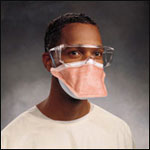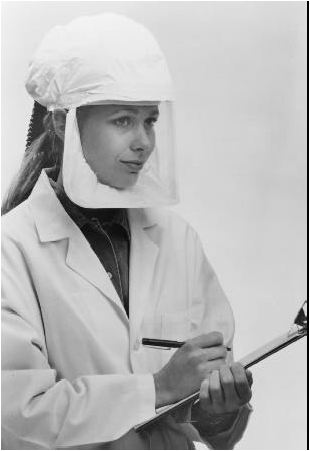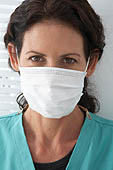8 Surgical Smoke
Survey of Healthcare Workers' Health and Safety Practices
Attachment I7_Module F_TC_72310
Secondary Hazard Module
OMB: 0920-0860
MODULE F: Surgical Smoke Form Approved
7/23/10 OMB No. 10AP-xxxx
Expiration Date: xx/xx/2011
PROGRAMMING INSTRUCTIONS APPEAR IN BLUE.
|
|||
A. |
During your career, how long have you worked in areas where surgical smoke was generated? |
|
|
|
|||
B. |
When was the last time you received training that addresses the hazards of surgical smoke? |
|
|
If you work for more than one employer, the following questions apply to your primary employer, i.e., the one for which you typically work the most hours. If you are self-employed, consider yourself the employer.
|
|||
C. |
Does your employer have standard procedures that address potential hazards of surgical smoke? |
|
|
D. |
At any time in the past 7 calendar days, did you work within 5 feet of the source of surgical smoke during LASER SURGERY? display calendar highlighting the past 7 calendar days. applies to all questions with ‘in the past 7 calendar days’ |
|
|
|
|||||
|
|
||||||||
E. |
At any time in the past 7 calendar days, did you work within 5 feet of the source of surgical smoke during ELECTROSURGERY?
Note: Electrosurgery includes electrocautery, diathermy, and ultrasonic devices.
|
|
|
|
|||||
IF Respondent MARKED ‘YES’ TO QUESTIONS D AND E, RANDOMIZE ORDER SUBMODULES ARE PRESENTED AND DISPLAY THE FOLLOWING NOTE: Because LASER SURGERY and ELECTROSURGERY (e.g., electrocautery, diathermy, and ultrasonic devices) involve different equipment, separate questions are being asked for each technique.
IF RESPONDENT MARKED ‘YES’ TO QUESTION D or QUESTION E è go TO APPROPRIATE SUBMODULE.
|
|
||||||||
SUBMODULE 1: Laser Surgery |
|
||||||||
During the past 7 calendar days, on how many days did you work within 5 feet of the source of surgical smoke during laser surgery?
|
|
|
|
||||||
|
|
||||||||
During the past 7 calendar days, how much total time did you work within 5 feet of the source of surgical smoke during laser surgery?
|
|
|
|
||||||
|
|
||||||||
3. |
During the past 7 calendar days, the total time you worked within 5 feet of the source of surgical smoke during laser surgery was… |
|
|
|
|||||
|
|
||||||||
4. |
During the past 7 calendar days, what was the total number of laser surgery procedures that were performed for which you were within 5 feet of the source of surgical smoke?
|
|
|
|
|||||
|
|
||||||||
During the past 7 calendar days, how often was local exhaust ventilation [e. g., portable smoke evacuator or room (wall) suction system] used while you worked within 5 feet of the source of surgical smoke during laser surgery?
Local Exhaust Ventilation (LEV) captures and removes contaminants at the point where they are being produced, such as a portable exhaust system with high efficiency particulate filters, or a flexible tube connected to a room (wall) suction system. LEV does not include blood suction canister systems
|
|
|
|
||||||
|
|
||||||||
6. |
During the past 7 calendar days, what type of local exhaust ventilation was used while you worked within 5 feet of the source of surgical smoke during laser surgery?
Please all that apply.
|
|
|
|
|||||
If ’Always’ marked in Question 5 è Go to Question 9. |
|
||||||||
What was the reason(s) local exhaust ventilation was not always used during laser surgery?
Please all that apply.
|
|
|
|
||||||
If only one reASON marked in Question 7 è Go to Question 9. |
|
||||||||
|
|
||||||||
Of the reasons you checked above, please indicate the most important reason local exhaust ventilation was not always used. |
|
list reasons marked in Question 7 (use radio buttons).
|
|||||||
|
|
||||||||
|
|
||||||||
Has exposure monitoring (e.g., air sampling) been conducted in the past 12 months to assess your or your co-workers’ exposure to surgical smoke during laser surgery?
|
|
|
|||||||
|
|
||||||||
10. |
In your current job, have you taken home any clothing that came into contact with surgical smoke generated during laser surgery?
|
|
|
|
|||||
Questions addressing work practices and use of personal protective equipment (PPE) will help us understand what is currently used and under what circumstances. Depending on your job and exposures, PPE may not be required.
|
|
||||||||
11. |
During the past 7 calendar days, how often did you wear protective gloves during laser surgery?
|
|
|
|
|||||
|
|
||||||||
12. |
During the past 7 calendar days, how often did you wear eye protection while you worked within 5 feet of the source of surgical smoke during laser surgery? Examples of eye protection include laser face shield, laser goggles, laser safety glasses. Note: Do not include personal eye glasses
|
|
|
|
|||||
|
|
||||||||
What are the reason(s) you did not always wear eye protection during laser surgery? Please all that apply. |
|
|
|
||||||
If only one reASON marked in Question 13è Go to Question 15. |
|
||||||||
|
|
||||||||
Of the reasons you checked above, please indicate the most important reason you did not always wear eye protection during laser surgery. |
|
list reasons marked in Question 13 (USE RADIO BUTTONS).
|
|
||||||
|
|
||||||||
During the past 7 calendar days, did you wear any of the following during laser surgery? Please all that apply.
|
|||
|
|
|
|
|
|
|
|
|
|
|
|
|
|
|
|
DISPLAY FOLLOWING NOTE ON SEPARATE SCREEN (except those who marked ‘i don’t know’): THE FOLLOWING QUESTIONs ASK ABOUT RESPIRATORS. Surgical masks and laser masks are not respirators
IF RESPONDENT MARKED ‘N95 respirator’, ‘HALF-FACEPIECE AIR PURIFYING RESPIRATOR’ OR ‘POWERED AIR PURIFYING RESPIRATOR’in question 15 è Go to Question 16 if rESPONDENT MARKED only ‘Standard SURGICAL MASK’, ‘LASER MASK’ or ‘none of the above’ in question 15 è Go to Question 17. if respondent marked ‘i don’t know’ in question 15 è Go to submodule 2 if respondent marked ‘yes’ in question e otherwise, exit module and go to core module if this is the first hazard module completed. if this is the second hazard module completed, end survey. end with ‘thank you’ statement. |
|||
16. |
How often did you wear a N95 respirator, half-facepiece air purifying respirator with particulate cartridge or powered air purifying respirator during laser surgery? |
|
|
|
|||
What were the reason(s) you did not always wear a N95 respirator, a half-facepiece air purifying respirator with particulate cartridge, or a powered air purifying respirator during laser surgery?
Please all that apply. |
|
|
|
If Respondent marked more than one reason in Question 17 è Go to Question 18. OTHERWISE è GO TO INSTRUCTIONS BEFORE QUESTION 19.
|
|||
Of the reasons you checked above, please indicate the most important reason you did not always wear a respirator during laser surgery. |
|
list reasons marked in Question 17 (USE RADIO BUTTONS).
|
|
|
|||
If R marked ‘N95 respirator’ or ‘Half-facepiece air purifying respirator’ in Question 15 è Go to Question 19. Otherwise è Go to SUBMODULE 2 IF respondent marked ‘yes’ in question e. otherwise, exit module and go to core module if this is the first hazard module completed. If this is the second hazard module completed, end survey. end with ‘thank you’ statement. |
|||
Have you been fit-tested for the respirator(s) you use during laser surgery?
|
|
All responses: if respondent marked ‘yes’ in Question e ègo to submodule 2. otherwise, exit module and go to core module if this is the first hazard module completed. If this is the second hazard module completed, end survey. end with ‘thank you’ statement. |
|
|
|||
SUBMODULE 2: Electrosurgery
|
|
||||||||
During the past 7 calendar days, on how many days did you work within 5 feet of the source of surgical smoke during electrosurgery?
|
|
|
|
||||||
|
|
||||||||
During the past 7 calendar days, how much total time did you work within 5 feet of the source of surgical smoke during electrosurgery?
|
|
|
|
||||||
|
|
||||||||
22. |
During the past 7 calendar days, the total time you worked within 5 feet of the source of surgical smoke during electrosurgery was… |
|
|
|
|||||
|
|
||||||||
23. |
During the past 7 calendar days, what was the total number of electrosurgery procedures that were performed for which you were within 5 feet of the source of surgical smoke? . |
|
|
|
|||||
|
|
||||||||
During the past 7 calendar days, how often was LEV used while you worked within 5 feet of the source of surgical smoke during electrosurgery?
Local Exhaust Ventilation (LEV) captures and removes the contaminants at the point where they are being produced, such as a portable exhaust system with high efficiency particulate filters, or a flexible tube connected to a room (wall) suction system. LEV does not include blood suction canister systems
|
|
|
|||||||
|
|||||||||
25. |
During the past 7 calendar days, what type of local exhaust ventilation was used while you worked within 5 feet of the source of surgical smoke during electrosurgery?
Please all that apply.
|
|
|
||||||
If ‘Always’ marked in Question 24 è Go to Question 28. If ’Sometimes’ marked in Question 24 è Go to Question 26. |
|||||||||
|
|||||||||
What was the reason(s) local exhaust ventilation was not always used during electrosurgery?
Please all that apply.
|
|
|
|||||||
If only one reason marked in Question 26 è Go to Question 28. |
|||||||||
|
|||||||||
Of the reasons you checked above, please indicate the most important reason local exhaust ventilation was not always used. |
|
list reasons in Question 26 (USE RADIO BUTTONS) |
|||||||
|
|||||||||
Has exposure monitoring (e.g., air sampling) been conducted in the past 12 months to assess your or your co-workers’ exposure to surgical smoke during electrosurgery?
|
|
|
|||||||
|
|||||||||
29. |
In your current job, have you taken home any clothing that came into contact with surgical smoke during electrosurgery? |
|
|
||||||
Questions addressing work practices and use of personal protective equipment (PPE) will help us understand what is currently used and under what circumstances. Depending on your job and exposures, PPE may not be required.
|
|||||||||
30. |
During the past 7 calendar days, how often did you wear protective gloves during electrosurgery?
|
|
|
||||||
|
|||||||||
31. |
During the past 7 calendar days, how often did you wear eye protection while you worked within 5 feet of the source of surgical smoke during electrosurgery? Examples of eye protection include face shield, goggles, safety glasses.
Do not include personal eye glasses
|
|
|
||||||
|
|||||||||
What are the reason(s) you did not always wear eye protection during electrosurgery?
Please all that apply.
|
|
|
|||||||
If only one reason marked in Question 32 è Go to Question 34. |
|||||||||
|
|||||||||
Of the reasons you checked above, please indicate the most important reason you did not always wear eye protection during electrosurgery. |
|
list reasons in Question 32 (USE RADIO BUTTONS)
|
|||||||
|
|||||||||
|
|||||||||
During the past 7 calendar days, did you wear any of the following during electrosurgery? Please all that apply.
|
|||||||||
|
|
|
|||||||
|
|
|
|||||||
|
|
|
|
||||||
|
|
|
|
||||||
DISPLAY FOLLOWING NOTE ON SEPARATE SCREEN (except those who marked ‘i don’t know’): The following questions ask about respirators. Surgical masks and laser masks are not respirators.
IF Respondent marked ‘N95 respirator’, ‘HALF-FACEPIECE AIR PURIFYING RESPIRATOR’ OR ‘POWERED AIR PURIFYING RESPIRATOR’in question 34 è Go to Question 35
if respondent marked only ‘standard SURGICAL MASK’, ‘LASER MASK’ or ‘none of the above’ è Go to Question 36
if respondent marked ‘i don’t know’ in question 34 è Go to submodule 1 if respondent marked ‘yes’ in question d.
otherwise, exit module and go to core module if this is the first hazard module completed.
If this is the second hazard module completed, end survey. end with ‘thank you’ statement. |
|||||||||
35. |
How often did you wear a N95 respirator, half-facepiece air purifying respirator with particulate cartridge or powered air purifying respirator during electrosurgery? |
|
|
||||||
|
|||||||||
What were the reason(s) you did not always wear a N95 respirator, a half-facepiece air purifying respirator with particulate cartridge, or a powered air purifying respirator while you worked within 5 feet of the source of surgical smoke during electrosurgery?
Please all that apply. |
|
|
|||||||
If Respondent marked more than one reason in Question 36 è Go to Question 37. Otherwise è Go to instructions before question 38.
|
|||||||||
Of the reasons you checked above, please indicate the most important reason you did not always wear a respirator while you worked within 5 feet of the source of surgical smoke during electrosurgery. |
|
list reasons in Question 36 (USE RADIO BUTTONS).
|
|||||||
If Respondent marked “N95 respirator” or ”Half-facepiece air purifying respirator” in Question 34 è Go to Question 38. Otherwise è Go to SUBMODULE 1 IF respondent marked ‘yes’ in question D. otherwise, exit module and go to core module if this is the first hazard module completed. If this is the second hazard module completed, end survey. end with ‘thank you’ statement.
|
|||||||||
Have you been fit-tested for the respirator(s) you use during electrosurgery? |
|
All responses: if respondent marked ‘yes’ in Question D ègo to submodule 1. otherwise, exit module and go to core module if this is the first hazard module completed. If this is the second hazard module completed, end survey. end with ‘thank you’ statement. |
|||||||
Thank you for participating in the NIOSH Health and Safety Practices Survey of Healthcare Workers. Your answers have been submitted.
Public reporting burden of this collection of information is estimated to average 9 minutes per response, including the time for reviewing instructions, searching existing data sources, gathering and maintaining the data needed, and completing and reviewing the collection of information. An agency may not conduct or sponsor, and a person is not required to respond to a collection of information unless it displays a currently valid OMB control number. Send comments regarding this burden estimate or any other aspect of this collection of information, including suggestions for reducing this burden to CDC/ATSDR Reports Clearance Officer, 1600 Clifton Road NE, MS D-74, Atlanta, Georgia 30329-4018; ATTN: PRA (10AP-xxxx).
| File Type | application/vnd.openxmlformats-officedocument.wordprocessingml.document |
| File Title | Please respond to the following questions by checking the box next to your answer choice |
| Author | Marci Treece |
| File Modified | 0000-00-00 |
| File Created | 2021-02-02 |
© 2025 OMB.report | Privacy Policy





